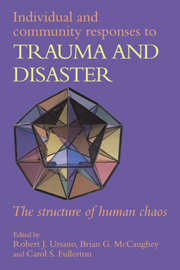Book contents
- Frontmatter
- Contents
- List of contributors
- Foreword
- Preface
- Part I Introduction
- Part II The nature of traumatic stress
- Part III The role of psychosocial context in responses to trauma and disasters
- 8 Social support and perceived control as moderators of responses to dioxin and flood exposure
- 9 Debriefing following traumatic exposure
- 10 Relocation stress following natural disasters
- 11 Group reactions to trauma: an avalanche accident
- 12 Community responses to disaster: the Gander plane crash
- Part IV Responses to trauma across the life cycle
- Part V Conclusions
- Index
12 - Community responses to disaster: the Gander plane crash
from Part III - The role of psychosocial context in responses to trauma and disasters
Published online by Cambridge University Press: 13 October 2009
- Frontmatter
- Contents
- List of contributors
- Foreword
- Preface
- Part I Introduction
- Part II The nature of traumatic stress
- Part III The role of psychosocial context in responses to trauma and disasters
- 8 Social support and perceived control as moderators of responses to dioxin and flood exposure
- 9 Debriefing following traumatic exposure
- 10 Relocation stress following natural disasters
- 11 Group reactions to trauma: an avalanche accident
- 12 Community responses to disaster: the Gander plane crash
- Part IV Responses to trauma across the life cycle
- Part V Conclusions
- Index
Summary
Several theoretical approaches or models are available to those interested in studying community responses to disaster and trauma. Unfortunately, recent experience with disasters proves that these models are overly restrictive. This chapter draws on observations following a major military air disaster to develop a new, expanded model of the impact on communities from such events. This model avoids the key restrictions of earlier models.
One critical restriction of community disaster models is the principal level of analysis that is adopted. Some models focus on individuals within the community, and aggregate individual reactions to form a picture of community response. Others view the community as a social unit that must be considered as a separate entity. These different views are usually assumed to be mutually exclusive, leading to a debate over which is more correct (Melick, 1985; Quarantelli, 1985; Powell & Penick, 1983; Tierney, 1986).
Tierney (1986) summarizes the controversy about theoretical orientation. Each orientation focuses either on a group or an individual level of analysis to the exclusion of the other. Those researchers who assume a community perspective conclude that psychological effects following disaster are minimal and short term, and that poor outcomes arise from inadequate disaster planning and resources on the part of community organizations (Quarantelli, 1985). The alternative orientation is a ‘psychological trauma’ perspective. It concludes that the catastrophic nature of the event and the subsequent trauma of dealing with the experience and its aftermath result in significant, adverse, and typically long-term psychological effects (Erikson, 1976; Lifton & Olson, 1976).
- Type
- Chapter
- Information
- Individual and Community Responses to Trauma and DisasterThe Structure of Human Chaos, pp. 267 - 284Publisher: Cambridge University PressPrint publication year: 1994
- 11
- Cited by



